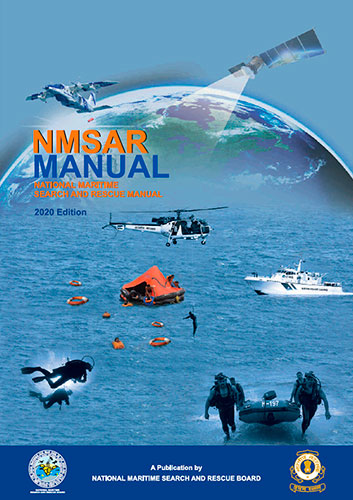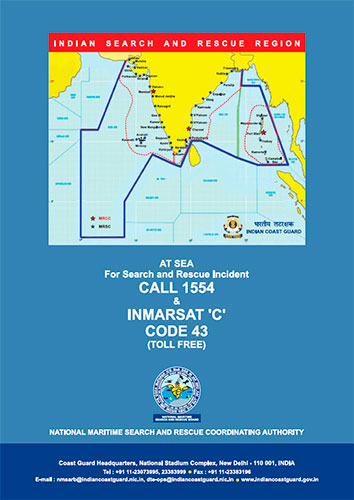NMSAR (National Maritime Search and Rescue) Manual/Национальное руководство по поиску и спасанию на море
Книга на английском языке.
The National Maritime Search and Rescue (NMSAR) Manual is the standard reference document and promulgates the agreed methods of coordination through which M-SAR operations are conducted within India. The Manual is used by all seafarers and those participating in M-SAR operations to supplement the International Aeronautical and Maritime Search and Rescue Manual (IAMSAR). The Manual aims to maximise the efficiency and appropriateness of the organisation of maritime SAR services and provide sufficient information about maritime SAR tasks, structure, planning, coordination, communication systems, coordination centre’s duties and cooperation related to SAR at sea/
Contents
Abbreviations and Acronyms
Glossary of Terms
Chapter 1. Scope and purpose
1.1 Introduction
1.2 Aim
1.3 Objectives
1.4 Benefits of SAR Services
1.5 Responsibilities for Maritime SAR services under International Conventions
1.6 Bilateral and Multilateral Agreements for Regional SAR System
Chapter 2. National maritime sar organisation
2.1 Indian Coast Guard and SAR Responsibilities
2.2 SAR Definition
2.3 Maritime Search and Rescue - CG Mission
2.4 National Maritime SAR Board
2.5 Terms and Reference of National Maritime SAR Board
2.6 Resource Agencies
2.7 Responsibilities of Resource Agencies
2.8 SAR Point of Contact
2.9 National Search and Rescue Plan
2.10 National SAR Manual
2.11 SAR Coordinating Committee
2.12 Search and Rescue Regions (SRR)
2.13 Indian SRR and SAR Organisation
2.14 The Indian Coast Guard SAR Organisational Structure
2.15 Maritime Rescue Coordination Centre in ISRR
2.16 Maritime Rescue Sub Centre (MRSC) in ISRR
2.17 Facilities and Equipment
2.18 Staffing
2.19 Adjacent SRRs
2.20 Unlawful Acts
2.21 SAR Operations by Maritime Rescue Services in time of Armed Conflict
2.22 SAR System Assessment
Chapter 3. Sar system components
3.1 SAR System
3.2 Components of SAR System
3.3 SAR Mission Organisation
3.4 Basic System Functions
3.5 SAR Management
3.6 SAR Coordinator
3.7 SAR Mission Coordinator
3.8 On Scene Coordinator
3.9 Aircraft Coordinator
3.10 Search and Rescue Units
Chapter 4. Satellite aided search and rescue
4.1 Introduction
4.2 Radio Beacons
4.3 Space Segment
4.4 Ground Segment
4.5 Distress Beacon Detection
4.6 Interpretation of COSPAS-SARSAT Distress Alerts
4.7 MEOSAR System
4.8 Data Distribution Procedures
4.9 GPS Aided Geo Augmented Navigation (GAGAN)
4.10 Navigation with Indian Constellation (NavIC)
4.11 Online Registration of 406 MHz Beacons (ELTs/ EPRIBs/ PLBs)
4.12 INMCC Operations
4.13 Additional Information on Indian MRCCs
Chapter 5. Maritime sar communications
5.1 SAR Communications
5.2 GMDSS Sea Areas
5.3 MRCC and MRSC Radio Requirements
5.4 Vessels/ Ships Radio Requirements
5.5 Distress Alerting
5.6 VHF, MF, HF RT
5.7 Digital Selective Calling
5.8 IMO Recognised Mobile Satellite Communication Services
5.9 Radio Communication Frequencies
5.10 MF Communications
5.11 HF Communications
5.12 VHF Communications
5.13 Vessel-Aircraft Communications
5.14 On Scene Communications
5.15 SAR Communication for Fishing Vessels
5.16 International Safety Net System
5.17 Maritime Safety Information
5.18 NAVTEX
5.19 NAVAREA VIII Coordinator
5.20 EPIRBs, ELTs and PLBs
5.21 Mobile Telecommunications
5.22 Vessel and Aircraft actions on observing AIS-SART or AIS MOB device signals
5.23 Maritime Identification Digits
5.24 Maritime Mobile Service Identity
5.25 Global Aeronautical Distress and Safety System (GADSS)
5.26 Aircraft Tracking
5.27 Reducing Response Time
5.28 First MRCC
Chapter 6. Maritime and aeronautical distress
6.1 General Maritime and Aeronautical Distress
6.2 Sources of Distress Input
6.3 Emergency Phases
6.4 Uncertainty Phase
6.5 Alert Phase
6.6 Distress Phase
6.7 Distress Alert from a Vessel
6.8 Distress Alert from an Aircraft
6.9 Vessel Distress Message
6.10 Visual Distress Signals
6.11 Additional Equipment
6.12 Methods of Distress Alert Notification/Signals
6.13 Overdue Vessel/ Aircraft
6.14 False Alerts
6.15 Preventing False Alerts
Chapter 7. Sar coordination
7.1 SAR System
7.2 SAR Stages
7.3 Awareness Stage
7.4 Notification by Other Sources
7.5 Initial Action Stage
7.6 Uncertainty Phase Initial Actions
7.7 Alert Phase Initial Actions
7.8 Distress Phase Initial Actions
7.9 SAR Planning Stage
7.10 Operations Stage
7.11 Conclusion Stage
7.12 Responsibilities of Designated MRCC/MRSC
7.13 Transferring Responsibilities between MRCCs and MRSCs
7.14 MRCC Procedures for Requesting SAR facilities
7.15 Position of Distress outside Indian SRR
7.16 Disembarkation of person rescued at sea
Chapter 8. Training and exercises
8.1 Training, Qualification and Certification
8.2 Special Training for SAR
8.3 Exercises
8.4 Building Professionalism
Chapter 9. Sar planning
9.1 General
9.2 Search Action Plan and Message
9.3 Own Search Planning
9.4 Planning the Search Area at Sea
9.5 Visual Search
9.6 Initial Position
9.7 Computation of Datum
9.8 Aerospace Drift
9.9 Maritime Drift
9.10 Other Water Current
9.11 Minimax Solution
9.12 Search Area
9.13 Total Probable Error
9.14 Search Radius
9.15 Search Area Development
9.16 Planning and Conduct of Search
9.17 Situation Reports (SITREPs)
Chapter 10. Search techniques
10.1 General
10.2 Search Techniques
10.3 Visual Search Patterns
10.4 Electronic Search Patterns
10.5 Night Search Patterns
10.6 Night Vision Goggles
10.7 Electro Optical Sensors
10.8 SAR Briefing
10.9 SAR Debriefing
Chapter 11. Air operations
11.1 Aircraft Intercepts
11.2 Aircraft Ditching
11.3 Assistance from Ships during Ditching
Chapter 12. Helicopter operations
12.1 Advantages of Helicopter
12.2 Resources
12.3 Capabilities
12.4 Helicopter Operation on Passenger/ Special Vessels
12.5 Considerations by SMC
12.6 Communications
12.7 Evacuation Missions
12.8 Standard Procedures for Helicopter Operations
Chapter 13. Rescue planning and operations
13.1 Rescue Planning
13.2 Sighting and Subsequent Procedures
13.3 Rescue by Aircraft
13.4 Rescue by Maritime Facilities
13.5 Special Requirements at Aircraft Crash Sites
13.6 Ditching Assistance
13.7 Rescue of Persons from Damaged, Capsized or Ditched Craft
13.8 Investigation of Situation
13.9 Prevention of Sinking
13.10 Lifesaving
13.11 Rescue Action Plan
13.12 Developing a Rescue Plan
13.13 SAR for Fishing Boats
13.14 Termination of Rescue
13.15 Wreckage Precautions/ Salvage/ Disposal
Chapter 14. Medical assistance at sea
14.1 Medical Assistance at Sea
14.2 Means of Evacuation at Sea
14.3 Medical Evacuation by Helicopter
14.4 Shore based Arrangements
14.5 Mass Casualty
14.6 MEDICO
14.7 Tele-Medical Assistance Services (TMAS)
14.8 Tele-Medical Advise at Sea
14.9 Means of Communications
14.10 Operational Guidelines on MEDEVAC at Sea
14.11 Care of Survivors
14.12 Handling of Deceased Persons
Chapter 15. Mass rescue operations
15.1 Overview
15.2 General Guidance for MROs
15.3 Communications for Mass Rescue Operations
15.4 MRO Communications in a Maritime Incident
15.5 Major Incident Coordination
15.6 Landing Sites
15.7 Planning and Response in Coordination with Shipping/ Airline Companies
15.8 Public and Media Relation for MRO
15.9 MRO Follow Up Actions
15.10 SAR within areas remote from SAR facilities
15.11 Care of Survivors
15.12 Termination of Rescue
15.13 Local Contingency Plan for MRO
Chapter 16. Rendering assistance
16.1 Actions by SRU on locating Search Object
16.2 Initial Action by Assisting Aircraft
16.3 Initial Action by Assisting Craft
16.4 Onboard Preparation
16.5 Vessels not Involved in Rendering Assistance
16.6 Rescue Planning on Scene
Chapter 17. Sar mission conclusion
17.1 Mission Conclusion
17.2 Closing SAR case
17.3 Suspending Search Operations
17.4 Extended Search Operations
17.5 Reopening a Suspended Case
17.6 SRU Return and De-alerting
17.7 Notifying Relatives
17.8 Final Reports
Chapter 18. Sar resources
18.1 Resources
18.2 Indian Coast Guard
18.3 Indian Navy
18.4 Indian Air force
18.5 National Hydrographic Office
18.6 Indian Space Research Organisation
18.7 India Meteorological Department
18.8 Major and Minor Ports
18.9 Other Resource Agencies
Chapter 19. Ship and aircraft reporting systems
19.1 Need for Ship Reporting System
19.2 Indian Ship Reporting System (INDSAR)
19.3 Reporting Procedures
19.4 Necessity to enhance participation of all Ships/ vessels in INDSAR reporting system
19.5 Pre-Arrival Notification of Security (PANS)
19.6 Space based AIS (SAT-AIS)
19.7 Vessel Tracking Websites
19.8 Aircraft Reporting System (ATS)
Chapter 20. Vessel identification system
20.1 Need for Vessel Identification System
20.2 INMARSAT Database
20.3 DG (Shipping) Database
20.4 INMCC Database
20.5 ITU Publications
20.6 MEREP Database
20.7 Automatic Identification System
20.8 Long Range Identification & Tracking (LRIT) System
20.9 Fishing Vessel Database
20.10 Internet Web Sites 251
20.11 Other Sources
Chapter 21. Inter agency coordination
21.1 SAR Co-ordination
21.2 Inter-Agency Exercises
21.3 Requirement for Information
21.4 Harmonization of Aviation and Maritime Search and Rescue
21.5 ICG-AAI SAR Coordination for Aviation Distress
21.6 Dissemination of Information
21.7 Inter-Agency Liaison
21.8 International SAR cooperation & Coordination with neighbouring countries
Chapter 22. Documentation
22.1 Case Title and Numbering
22.2 SAR Folder
22.3 Master SAR Folder
22.4 Diary of Events
22.5 SAR Operations Log Book
22.6 SAR Incident Processing Forms
22.7 SAR Case Summary
22.8 SAR Charts
22.9 Computer Database
22.10 Case Studies
22.11 Sharing of SAR Information
Chapter 23. Public relations
23.1 Public Relations
Chapter 24. Computer resources
24.1 Computers Resources
24.2 Computer communications
24.3 SAR data providers
24.4 Computer-based search planning
24.5 Computers and Related Features
24.6 Electronic Data Transfer
24.7 Computer Database
24.8 Preservation of SAR Data
24.9 Computer Training
Chapter 25. Check off lists
25.1 SAR Incident Data
25.2 Person Overboard
25.3 Drowning near Shore/River
25.4 Medical Evacuation
25.5 Mass Casualties
25.6 Cyclonic Disturbances
25.7 Stranded/ Aground Vessel
25.8 Hijacked Vessel
25.9 Vessel in Distress
25.10 Air Craft in Distress
25.11 SAR for Fishing Boats
25.12 Life-saving and rescue equipment to be carried by SRU




